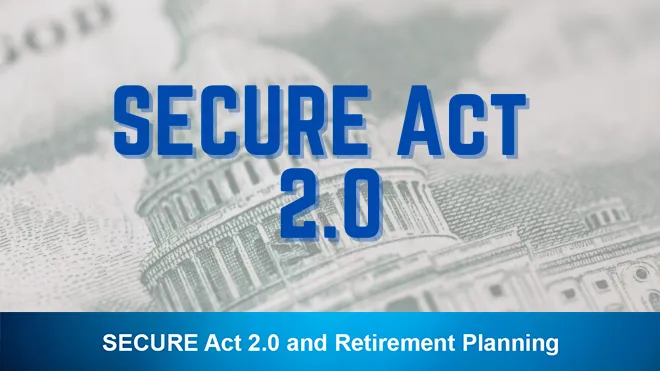Maximizing the Return on your Savings
By info@landmarkwealthmgmt.com,

After nearly a decade of near zero interest rates, 2022 was a year in which the Federal Reserve aggressively reversed course and increased interest rates multiple times. The aggressive moves by the Fed had a major impact across the financial markets. One of the few positives for 2022 was the increase in return that good savers good generate.
A savings account is never a great long-term investment option. However, it’s imperative that all investors maintain some degree of short-term liquidity for emergencies. In general, it’s a good idea to have at least six months to one year of an emergency fund so you don’t have to liquidate a longer-term investment option at an inopportune time. With the recent increases in savings rates, investors are closing in on rates of return that have not been seen since before the 2008 financial crisis.
Money Markets & Savings Account
Historically money markets offer savings rates that have higher yields than a typical savings account at a national bank. Money market accounts are essentially a mutual fund that invests in short-term debt instruments with maturities that can be as short as 30 to 90-day maturities. As a result, money market rates tend to adjust very quickly to rate increases or decreases. The goal of a money market is to always maintain a constant $1 dollar share price with a changing rate of interest. There have been some extremely rare circumstances in which a money market has “broken the buck” and returned less than the $1 per share price. This happens when the underlying debt they invest in such as short-term corporate commercial paper defaults. However, that is extremely rare. In the current interest rate environment, even a government reserves money market in which all of the debt is government backed and there is no default risk can pay nearly 4%.
Another option is the traditional FDIC insured savings account. Today competitive savings rates are upwards of 3% as well. One option that offers some better rates can be found in the online banking space. The lack of “brick and mortar” costs associated with online banks will often lead to interest rates that are more competitive than a larger national bank found on every corner in the nation. It’s important to shop these rates from bank to bank, as there can be vast differences in the rates offered. A savings account is an asset to you, but a liability to the bank. As such, many of the larger banks that have excess reserves have no incentive to offer better rates to increase deposits. Many of the smaller regional banks are often more competitive.
Traditional savings and money market accounts are useful when it comes to fulfilling the need for an account that will require day to day liquidity.
Certificates of Deposit
CD’s are still a viable option as a short-term savings vehicle. While the rates may not always seem that much more attractive than a typical savings/money market, they may still make sense. If you likely have no need to spend down cash other than an unforeseen emergency, then a CD may still make sense if it’s short-term. Perhaps one year to possibly 18 months. Even if you need to lock in a CD for 3-5 years, typically the only penalty you would incur should you need to break it would be the loss of the interest that you would have earned. There is generally no risk to your principal as long as you stay within FDIC limits. Today a one-year CD is paying in the vicinity of 3.5%-4% as a current rate of return.
Short Term Bond Funds
An ultra-short term bond fund comprised of very-high credit quality is not a savings account. They typically come with very nominal downside risk for the investor who doesn’t have any known short-term needs. However, with the aggressive rates hikes of 2022, it was a terrible year for bonds, and even the ultra-short-term bond funds saw negative returns. In some of the better cases, they still lost around -1% for the year.
It’s important to pay close attention to credit quality, as a short-term bond fund in an extreme market downturn can see noticeable short-term losses if they experience sizeable defaults. While these declines are unlikely to look anything like the declines seen in equity markets, they can still be impactful.
At the height of the market panic in late March of 2020 it was not uncommon to see a 5%-10% decline in short-term funds that took greater credit risk. One clear indicator is the yield of a fund. If the yield is noticeably greater than the rest of the market, then more than likely it’s worth looking closer at the credit rating of the issuers the fund is buying. In contrast, most short-term funds of very high-quality debt actually appreciated as the markets plummeted in March of 2020, yet still saw declines in 2022 in the face of significantly higher rates. Today, many of these short-term bond funds have yields in excess of 4%.
Annuities
Many of us have had the local bank teller notice a large cash position and encouraged us to speak to the local investment professional at the bank. One such option they will propose is what is known as a Single Premium Deferred Annuity (SPDA). The SPDA is an insurance contract that functions much like a CD with no fluctuations to your initial investment principal. They are not insured by the FDIC, but rather backed by the insurance company, and sometimes further backed by the state insurance commissioner’s office up to certain limits.
The advantage of the SPDA is that they sometimes offer rates that are a little better than a CD, and the interest is tax deferred. Once they mature, the contracts usually have a floor interest rate that you can continue to collect without exchanging into a new annuity. At times those interest floors have been attractive compared to current market rates.
The disadvantages are they don’t typically permit you to break the contract penalty free. What you can often do is withdraw a percentage of the contract, sometimes 10% per year without penalty. There is also a penalty on withdrawals made before age 59 ½, so it’s not a suitable option for those younger in age.
Credit Risk Caution
One area to be very cautious is in the floating rate space. Floating rate notes are extremely short-term corporate debt that is only available to institutional buyers. However, a number of mutual fund companies offer floating rate funds that buy such paper and offer more attractive yields. A quick look at a chart of most floating rate funds will show price changes that are typically between 2%-3% principal fluctuation during positive or negative market changes.
During the 2008 financial crisis when the credit markets came to a near total freeze, these floating rate funds saw average declines of -27%. This is an area that is often mistakenly looked at as a short-term cash position. We would caution against such an approach. Floating rate securities can be an attractive investment at times, but any vehicle that offers substantive credit risk is not an ideal savings alternative.
In the current interest rate environment higher quality floating rate funds pay in excess of 4%, but not much more than a higher quality short-term bond fund. Some of the lower quality funds with much more credit risk can offer as much as an 8% yield, but much more potential for volatility.
When it comes to an emergency fund, it’s important to remember that the goal is stability at the best interest rate available with a reasonable amount of liquidity, and not to become too frustrated with the low returns. Emergencies often happen during periods of great market volatility. What you don’t want is to find yourself in a position of having to sell a quality asset at a depressed price, therefore eliminating your ability to benefit from an eventual price rebound.
Maintaining a proper emergency fund should actually provide you with more comfort in your ability to take greater risk with your other investment accounts with the knowledge that the short-term risk has already been addressed.
2022 was a year in which inflation reared its ugly head in a way not seen in forty years. In reality savers were better off with rates at 0.50% and inflation at 2%, which was a net real loss of -1.5% annually on the purchasing power of cash. Today with savings accounts at 3-4% and inflation at 7%, that is a real net loss of between -3% to -4% annually on the purchasing power of cash. However, as inflation moderates downward over time, savers will fare much better unless the Fed begins to aggressively cut rates again. Until that time, it’s even more important that investors maximize the rate of return on their emergency funds in this high inflationary period in order to close the gap between what they earn and what it costs them to live.
Filed under: Articles
Comments: Comments Off on Maximizing the Return on your Savings





